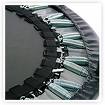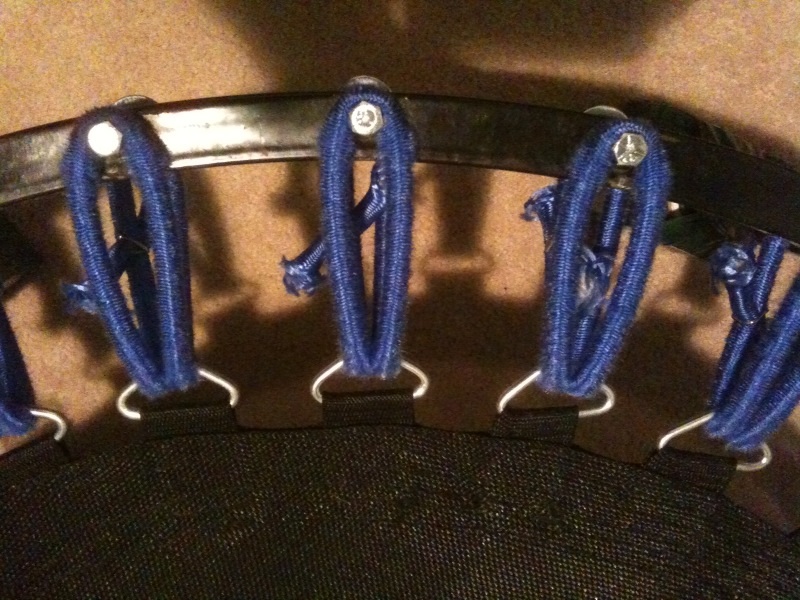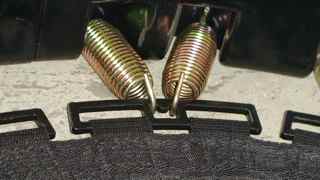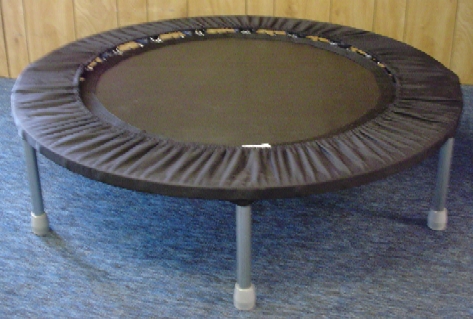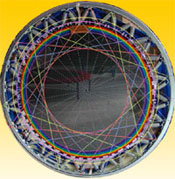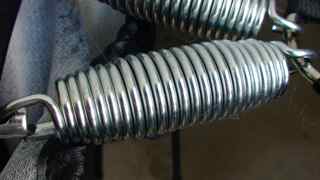Buying Guide
For years, I have been testing and comparing rebounders independently to find the best rebounders that will hold up and maintain a 3 G force required to squeeze the vessels in the lymphatic system.
The rebounder I pick out for you will have the least ballistic impact while being responsive so you don't have to "over bounce"to avoid issues that come with rebounders that have too much or too less acceleration or too little or more deceleration. The bounce rate and efficiency of each rebounder can only be found by the weight and jumping style of the user.
The comprehensive field tests and comparative reviews of the best in rebounders will help guide you. Get informative, clear, concise explanations of what separates the lymph-worthy rebounders from the rest. I accept no manufacturers advertising to prevent being biased and subjective. Play no favorites and pull no punches. Read at length the good, the bad, and the so-so about each model so you can pick the model that best fit your needs and your budget.
Things to Consider:
Bounce: Do you want a hard bounce, a soft bounce, self-adjusting bounce to your body weight, firm around the edges and soft in the middle or the near the same tension over the whole mat with self adjusting springs. Depending on if you are focusing on lymphatic movement that requires springs needed for the Health Bounce or you want a firm mat like you see in the gyms that are great for jogging, its your choice and you have the right to know before buying without having to pay a restocking fee for making the wrong decision if you haven't jumped on them. This is why it is helpful to talk to someone who can help choose a rebounder based on the person and the rebounder. NOT JUST SOMEONE THAT SAYS THEIR BRAND IS THE CURE ALL FOR EVERYONE. THIS IS WHY THERE ARE DIFFERENT TYPES OF REBOUNDERS.
Inversion: Some will invert your ankle, some won't. Some you can get away buying a cheaper model if you wear shoes and some if you stand equal distance apart from the center where you don't fall into the "cone". I will find out if you want to wear shoes or not or you want to be able to jump anywhere on the mat without being mindful of your foot position.
Noise: Some are just noisy no matter if you oil them or not. Some get noisier not from just the springs but the way they wobble due to a cheaply made design and materials used. Some bungees get noisy after you sweat on them and some start to fray if in a humid place. Some springs use a softer alloy that don't make as much noise while some get noisy as soon as the oil dries up. Some make a crunch sound and some make a squeaky sound. The more expensive springs with high grade alloys tend to make the least amount of noise and very quiet when oiled.
Comfort: Some feel plush and like a pillow top and some get the job done but don't have the comfort. If you want comfort or you just want the benefits no matter what the comfort, both can be done.
Frame: Some frames start to wobble and get noisy and some frames have a wobble that is good for bouncing that rids tension from the rebounder. The more folds a rebounder has, the more it can keep you in the center if done right. 3 folds in a triangle like position keeps you in the center as you jump against the grain. Non folding rebounders, if the frame is not good, can warp and you will find you will have to put a piece of cardboard under one of the legs in due time just like a table that warps over time that never seems to lay flat without sticking something under a leg.
Springs: Some you have to change every year or two, and others never. Depending on the type of bounce you want and your weight and jump style (do you want to jump with your feet always even apart from the center), you will have to decide which type of spring is best for you. Do you want high bounces with slower deceleration or faster deceleration that will give you 2 g forces or do you want 3 g forces. Do you want more or less bounces per minute. If you are watching a movie and will be on the rebounder anyway, you might not care and just want a soft bounce and take 2 to 3 times as long to get the same results as the "picture perfect" Health Bounce.
Self Adjust: Some springs bottom out when you stand next to them and others self adjust. If springs on one side get too loose and the other side is more firm, it can throw me off balance. Triple tiered springs will usually help if someone has a balance problem or doesn't want to have their feet inverted. Or, if you want a soft bounce that gets you the 3 g forces, you can utilize a full spring without a "self adjust" spring but by using all the coils every time you WILL HAVE TO CHANGE SPRINGS EVERY 1 TO 2 YEARS.
Digitally Tuned: Do you want your springs tuned so that each spring is the same or do you want each spring to be analog made so that it was not tested or tuned for the same tone. You can tap on each spring with a spoon and you can tell if they sound differently when they are on the rebounder. This is very important. I WOULD RETURN ANY SPRING THAT DOESN'T SOUND CLOSE TO THE REST OF THEM.
Mat: Some fray and look like it came from a potato sack. Others are made of Permatron. Some are even 2, 3, or even 4 ply that give more comfort and less mat sag. The bounce is as good as the mat, not just the springs.
Cover: Some have covers and some don't. Some have thicker covers than others too. It' not pretty to get your foot stuck without having a cover.
Chemical smells: Some of them leach a smell similar to a tire store. Some only do that when it is left in the sun. Some don't have any formaldehydes or other chemicals that leach. I will find out if you have a chemical sensitivity before I sell you a rebounder. If used out doors it doesn't matter only if you bring it in from the hot sun on the leaching models. If used in a cool place, on some there is no problem.
Storage: Some are easier to store and put together than others. Some of them are so hard to open it's very dangerous. Some open very gently that even someone very weak could open. Some have problems with getting the cover chewed up in the hindges.
Price: Some are more expensive than others. The better quality up front the less you usually pay in the end as you don't have to constantly change springs. By getting good springs that don't always use the entire spring or on some, ones that are made for a certain type of bounce for a person's weight that USES THE FULL COILS in each spring that is made with the right alloy in mind to avoid over stretching, then you don't always have to get a self adjusting spring. If a spring has too much weight on it and it stretches out it can loosen the spring, ALTHOUGH IT MIGHT NOT BREAK, but you can definitely experience a lack of responsiveness and lack of the original G force it gave when new.
All of the rebounders are good. The question is, "which one is the best fit for you?" If you're not sure of the answer, call!
These questions will isolate all rebound-relevant issues. When you call me, I will go over each question. I don't just sell someone a rebounder without giving my help. I rarely get rebounders returned because I give full service in helping people choose. You actually choose the rebounder, not a SALESPERSON TELLING YOU WHICH TO BUY.
Please give me feedback on my site!
(good feedback=discounts!)
comments:
I will NEVER share your contact information without your permission!
Thanks!
Please go over these questions before calling me. It will save you a lot of hassle later by not getting the wrong rebounder.
1. Are your ankles weak, and do you possibly have trouble with pronation (cocking-inward)?
2. Are your knees weak?
3. Are your connective tissue and joints sensitive to vertical impact?
4. Is your sense of balance and equilibrium while in motion:
5. Are you concerned with your weight?
6. Do you suffer from back pain?
7. Are you sensitive to chemical and plastic leaching (vapors extracted by heat from synthetic materials)?
8. Are you interested in rebounding to improve your health (lymph workouts)?
9. Are you interested in rebounding as a low-effort form of fat burning or cardio exercise?
10. Do you find repeated jarring motion traumatic in my situation?
11. How much do you weigh?
12. Is noise level an issue where you plan to rebound?
13. Where do you plan to keep your rebounder?
14. Do you plan to move your rebounder from place to place?
15. Is fun an important factor in your rebounding activities?
16. If you're going to sweat a lot on the rebounder, how do you prefer to clean it?
17. Which grade of rebounder do you want?
18. Which rebounder are you most interested in?
Take the Rebounding Quiz Below!
If other, which one?
Name
Email
Best time to call
Number
Time Zone
Please scroll down to see the rebounder quiz.
Please understand this before dissecting the rebounder
How Rebounding Really Works..
and why you want to create a hydraulic pump that requires at least 2 G forces
or 3 G forces for optimal pumping pressure:
Here is how rebounding works when you have the right rebounder.
First, the lymph vessels move a fluid that that drains all the spaces in the tissues that carry wastes produced by the body and outside toxins. The anti-bacterial lymph fluid acts as a sponge to soak up bacteria and eventually bring all the wastes to the large intestine. People with sluggish lymphatic systems don't have efficient lymphatic systems and all the wastes don't get soaked up and you can look at a person and see what happens when their system is not working right, they have inflammation all over their body, their flesh is very puffy, and usually they have a whitish haze on the back of their tongue.
The right rebounder will give you 3 G forces or very close to 3 G forces when bouncing with your feet never or barely leaving the mat. This is when you know you have the right rebounder that fits your weight and are getting the best results when doing the Health Bounce. Some rebounders can give 3 G forces but require you to jump higher and give fewer bounces creating a slower hydraulic lymphatic pump and a less efficient rebounding session.
HealthyTrampolines.com
1-877-354-3778
Open from 8am till 10pm
1-877-354-3778
Open from 8am till 10pm
Buying a rebounder based on your weight:
100-120 POUND PEOPLE
This is when it gets extremely hard to harness enough g force on certain rebounders. The springs on rebounder that are not tapered or tiered will use the entire spring and if someone is very light, they don't utilize all the coils. For doing lymphatic rebounding, the best one I choose for this weight class is the Cellerciser as it uses just the belly of the spring, the middle part. The 2nd choice is the Lymphaciser. It utilizes the entire spring and the springs are very tiny and have smaller coil counts and lower diameter so the entire spring is utilized.
120-140 POUND PEOPLE
When doing the Health bounce, at this weight, the springs on rebounders under 90 grams tend to be less jarring for people in this weight range. The Urban and Lymphaciser all have very lightweight springs and it doesn't take much to open the minimal tension of the spring. But with higher jumping, the short coiled, lightweight springs expand to its maximum tension and it can feel jarring. If a small spring has tensile strength of 180 Newtons and you are are are forcing 200 Newtons on it, this is when the springs lose their yield strength and soon snap. If just doing the Health bounce only, the Reboundair an the Lymphaciser are my two top picks. Depending how high someone is going to jump out of the mat will determine which of these two is better.
140-160 POUND PEOPLE
This is when about half the spring is utilized. The Needak feels great for people in this range as it harnesses all the G force from the spring without bottoming out. The Cellerciser will use the first and 2nd tier in this range. The Urban is definitely out. This is when most of my customers complain of jarring. It just enough weight to feel that sharp impact. The Lymphaciser also has a great feel in this range. With the bungees, at this weight it will take slightly more effort to jump (free bounces). In a nutshell, most people in this range start leaning towards the smaller mats. At higher weights than this it starts to decelerate more and cone in and invert the ankles. For doing lymphatic bouncing, my favorite 2 picks are the Lymphaciser and Cellerciser.
160-180 POUND PEOPLE
This is the most popular weight range of users that use a rebounder for lymphatic drainage, mostly women. This is when there is enough weight to harness enough G force in the springs but to be careful of jarring or inverting the ankles as the rebounder sinks in more at this weight. The problem in this weight range is usually inversion of the ankles as people jump in the sweat spot of the rebounder. My favorite 2 picks are the Needak and Cellerciser in this range. The Needak gives fewer bounces per minute and deeper flushes while the Cellerciser gives more bounces per minute but shorter flushes. The Cellerciser, with its third tier giving that boost acceleration, wins in this category. If you try both of these rebounders side to side at this weight class you will easily tell the difference. The Lymphaciser feels very hard for this weight class. The Reboundair feels a little harder at the bottom of the bounce as it has much fewer coils giving it less deceleration into mat for those that have knee or ankle problems.
180-200 POUND PEOPLE
This range of rebounders is where it's hard to get it just right. Mostly men in this weight range. In order to get the Health bounce, I would recommend a spring rebounder or a bungee rebounder that has the tensile strength high enough that the springs don't can't fit a toothpick between any spaces in between the coils while standing on the rebounder. On rebounder with low carbon springs even if the same size spring as a high carbon spring, on some rebounders with 200 pound people on the mat, the springs allow a toothpick to go between. Also, if after a few months the springs allow the toothpick to go in between, then you know you have low carbon springs that have high tensile strength at first but as the coils open and close, like a paperclip finally snapping when it gets hot and cold too many times, the minimum tension gets lower and the original maximum tension is about half gone.
210-220 POUND PEOPLE
This is when I would only use a high carbon spring, especially if doing the lymphatic Health bounce. A tapered spring or triple tiered spring would be best as the belly of the spring will lose its initial tension and the tiers would keep the integrity of the bounce for years to come. The belly of the spring would hold the weight in a way. My top pick for a rebounder in this weight range would be the Cellerciser or the Jumpsport (smallest mat model) with adjustable bungees to set it at the highest tension level. The Lymphaciser kind of has the bottom out feel when jumping high but is is OK for doing the Health bounce only as long as you aren't jumping too high out of the mat. Urban, forget it. Reboundair, try it and you will see. The Needak is my second favorite with this weight range.
220-240 POUND PEOPLE
No questions asked, the 106 gram high carbon steel Cellerciser is my only pick for doing the Health Bounce in this range. The yield strength of the 3rd triple tier comes in play for this weigh range. This is when many people find they have to bounce near the edges of the mat to avoid the mat sinking to the floor at 200 to 240 pounds. Although many other rebounders can hold the weight at first, the 80 to 90 gram spring rebounders, unless they are high carbon steel, probably won't last as long. The springs never really break but they lose their responsiveness so you don't accelerate with the same G force as when the rebounder springs were new. The Needak is still gonna be my 2nd favorite. Based on my tests, I got fewer flushes per minute doing the Health bounce.
240-280 POUND PEOPLE
This is when many people bottom out their rebounder. The Needak Hard Bounce although it's made for people over 300 pounds gives a better Health bounce but a little firm for doing high bouncing in this weight range. The Cellerciser is gives the best bounce fore people up to 300 pounds and utilizes the 3rd tier of its spring without overextending it. The Cellerciser spring can actually hold up to 400 pounds but its exerting too many newtons of force on the springs and it won't keep its initial tension. It's simple math, if you go over the newtons the spring is capable of, the spring gets damaged. At 240 to 280, I choose the Cellerciser as my favorite.
280-300+ POUND PEOPLE
At this range, the Needak Hard bounce is my favorite as long as someone is going to be doing higher jumping and not just the lymphatic health bounce. For Just doing the Health Bounce only, I like the Cellerciser but for doing exercises that require jumping out of the mat, the Needak Hardbounce is my favorite. Based on the fact that many people are not just going to do the Health Bounce, I pick the Needak Hard Bounce Rebounder as my favorite.
Over all, the higher carbon springs of the Needak and Cellerciser are the rebounders that are my top picks for doing not just the Health bounce for all types of exercise. The Cellerciser gives the most even bounce. The Lymphaciser is my favorite rebounder if only doing the Health Bounce. It gives the most bounces per minute with the most G force of its kind but I do not recommend it for doing any other type of bouncing. The springs are too short and low mass to keep up its tension.
I hope that this helps you understand more on how to pick out the right rebounder for your weight range. If you need to ask any questions before you pick out the right rebounder for you, you may call me or email me and I will try to answer all your questions.
And remember, this is based on landing on your heals first. Landing on your toes first takes out the instant force applied to the springs and is the wrong way to do the Health Bounce.
Take the
